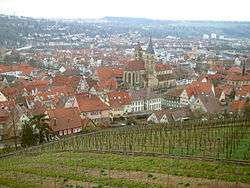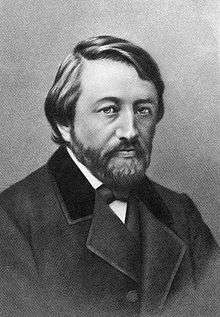Esslingen am Neckar
| Esslingen am Neckar | ||
|---|---|---|
 | ||
| ||
 Esslingen am Neckar | ||
Location of Esslingen am Neckar within Esslingen district 
 | ||
| Coordinates: 48°44′0″N 9°19′0″E / 48.73333°N 9.31667°ECoordinates: 48°44′0″N 9°19′0″E / 48.73333°N 9.31667°E | ||
| Country | Germany | |
| State | Baden-Württemberg | |
| Admin. region | Stuttgart | |
| District | Esslingen | |
| Government | ||
| • Mayor | Jürgen Zieger (SPD) | |
| Area | ||
| • Total | 46.43 km2 (17.93 sq mi) | |
| Population (2015-12-31)[1] | ||
| • Total | 91,271 | |
| • Density | 2,000/km2 (5,100/sq mi) | |
| Time zone | CET/CEST (UTC+1/+2) | |
| Postal codes | 73701–73734 | |
| Dialling codes | 0711 | |
| Vehicle registration | ES | |
| Website | www.esslingen.de | |
Esslingen am Neckar is a city in the Stuttgart Region of Baden-Württemberg in southern Germany, seat of the District of Esslingen as well as the largest city in the district.
It is located on the Neckar River, about 14 kilometres (9 miles) southeast of Stuttgart city centre. The regions surrounding the city of Esslingen are also mostly developed.
Esslingen was a free imperial city for several centuries until it was annexed by Württemberg in 1802.
History
Prehistoric times
There is archaeological evidence that what is now the city of Esslingen was settled since the Neolithic. Traces of human settlement found at the site of the city church date back to around 1000 B.C.
Roman times
In the 1st century AD the Esslingen region became part of the Roman Empire. During this period a Roman warehouse was located in the area of Oberesslingen. The nearest major Roman settlements and garrisons were at Cannstatt and Köngen.
Middle Ages
Esslingen was first mentioned in 777 as Ezelinga in the last will of Abbot Fulrad from Saint-Denis (near Paris), the chaplain of Pippin and Charlemagne. He bequeathed the church sixth cell upon the river Neckar to his monastery, Saint-Denis. He also brought the bones of Saint Vitalis to Esslingen, which made it a destination for pilgrims and led to its growth.
Around 800 Esslingen became a market town, its market rights being certified in 866. In 949–953 it was a possession of Liudolf, Duke of Swabia. Esslingen received city rights in 1229 under Emperor Frederick II. During the same period the still extant Neckar bridge was built, making Esslingen a major centre for trade on the route between Italy, Switzerland, and northern Germany. Taxes provided by the bridge and market led to further growth of the town, as did the export of the highly regarded wines from the region.
The period between the 13th century and 16th century saw many conflicts between the Free Imperial City and the Counts of Württemberg (later Duchy of Württemberg). About half the population lost their lives in the Thirty Years War between 1618 and 1648 through famine or epidemics. Esslingen lost its independence as an Imperial city in 1802-1803, becoming part of the Duchy of Württemberg.
19th century to date
The beginning of 19th century was characterised by industrialisation. Glove manufacturing, food processing, textiles, and metal working were early industries in Esslingen. On 20 November 1845 the first train ran from Cannstatt to Esslingen station.
Esslingen was occupied by U.S. soldiers in April 1945, towards the end of World War II. During the war the city suffered very little damage, thus the medieval character of its city centre has been mostly preserved.
After the Second World War about 47,000 people moved to Esslingen, mostly refugees and displaced persons from East Germany. Housing developments in Oberesslingen and Zollberg were created to overcome the shortage of housing.
In 1973 Nürtingen district was merged with Esslingen am Neckar, making Esslingen the seat of a much enlarged district.
Transport
Air transport
Stuttgart Airport, the largest airport in Baden-Württemberg, is located in Esslinge District, roughly ten kilometres south of the town, on the border with the town of Leinfelden-Echterdingen. A plane owned by Lufthansa has been named after the town.
The junction on the Bundesautobahn A 8 Karlsruhe-Munich which serves Esslingen is just after the airport when travelling towards Munich.
Road Transport
Esslingen is directly on the B10 State Highway which runs as a dual carriageway from Stuttgart to Süßen, and continues onward to Ulm. The exit for Esslingen, just after the B10 passes under the ancient Pliensau Bridge, is particularly unusual, because in the direction of Ulm there are two entry and exit points to the dual carriageway. This makes it is possible to reach the centre of Esslingen directly from Stuttgart, and to drive from central Esslingen directly onto the Dual Carriageway in the direction of Ulm without having to pass traffic lights.
Despite the six to eight lanes on the new Piensau Bridge and the surrounding roads, the infrastructure around Pliensauvorstadt and the route to Zollberg still suffers from frequent congestion.
Esslingen is also on the German Timber-Frame Road.
Long Distance Rail Transport.
Esslingen (Neckar) station is on the Fils Valley Railway and is served by line S 1 of the Stuttgart S-Bahn and regional services. The town is on the main rail line between Stuttgart and Ulm, operated by Deutsche Bahn, the main German rail operator. In 2009, the company named a high speed 'Intercity-Express' train “Esslingen-am-Neckar”
S-Bahn
The Stuttgart S-Bahn line S1 which operates between Kirchheim-unter-Teck and Herrenberg via Stuttgart centre, serves the stations of Mettingen, Esslingen (Neckar), Oberesslingen and Esslingen (Zell). Under the planned rebuilding of the railways in central Stuttgart under the Stuttgart 21 scheme, the S1 will be shortened to operate from Kirchheim unter Teck as far as Stuttgart Schwabstraße station.
Direct bus connection to Stuttgart Airport.
To avoid the long S-Bahn route to the airport via Stuttgart, the Bus 122, operated by the END Company, now runs directly from the cantral bus and rail interchange to the airport via Ostfildern Scharnhausen.
Urban Tramway
The Esslingen Urban Tram system was opened in May 1912 and closed on the 7th of July 1944 after 32 years of operation. It was replaced by trolley buses. The operating company, the Esslingen Städtische Straßenbahn (ESS, translated Esslingen Town Tramway) changed its name in 1944 to the Städtischer Verkehrsbetrieb Esslingen (SVE, or “Esslingen Transport Company”).
Former Interurban Tram
On the 18th of December 1926 the Esslingen-Nellingen-Denkendorf (END) interurban tram began operating. This was the last tram system to be built in Germany before the wave of closures later in the century: after this date permission from the authorities was only given for extensions to existing systems. The tram had to negotiate a five kilometre gradient out of the Neckar Valley to reach the towns and villages of the Eastern Filder region. In total, the system transported 153 million passengers from Denkendorf and later from Neuhausen to Esslingen, and took delivery of two new open trams in 1958. The line was discontinued in February 1978.
Trolley bus and diesel bus
Esslingen, along with Solingen and Eberswalde, is one of the last three German towns which still use trolleybuses. The SVE currently operates two lines using electric power:
101: Oberesslingen Lerchenacker Endstation – Esslingen railway station- - Stuttgart Obertürkheim railway station.
118: Esslingen Railway Station – Zollberg.
Apart from this around 50 taxis operate in the town.
Car-Sharing
In 1994 A car-sharing company opened a station in Esslingen.
Rebuilding of bus/rail interchange.
An ambitious redevlopment project has been in progress since 2004 in the area near the railway station. The current phase of this project is a large redevelopment of the station forecourt costing about 7.4 million Euros. The Baden-Württemberg State Environment and Transport ministry helped fund this with a grant of 4.9 million Euros. During 2009 the Neckarstraße was diverted along unused land on the railway station and lengthened to the west of the site. The next phase, completed in November 2014, was a large-scale redevelopment of the station forecourt to create a bus and rail interchange.
Hochschule Esslingen
The city is home to the Esslingen University of Applied Sciences (German: Hochschule Esslingen). It is known for its mechanical engineering and automotive engineering courses, and also for its three international master's programs (MBA in International Industrial Management,[3] MEng in Automotive Systems,[4] MEng in Design and Development in Automotive and Mechanical Engineering),[5] which are organised by the Esslingen Graduate School[6] and taught completely in English.
International relations
Twin towns – sister cities
Esslingen am Neckar is twinned with:[7]
Notable people

.jpg)

- Thommie Bayer (born 1953), writer, musician and painter
- Otto Borst (1924–2001), German historian
- Karl Deffner (1817–1877), manufacturer, member of parliament
- Cristian Fiél (born 1980), Spanish-German football player
- Volker Hauff (born 1940), German politician, former Member of Bundestag, former Lord Mayor of Frankfurt am Main (SPD)
- Wolfgang Fritz Haug (born 1936), philosopher
- Otto Hauser (born 1952), German politician (CDU), former Member of Bundestag and retired parliamentarian secretary of state
- Walter Hirrlinger (born 1926), German politician (SPD), Member of Landtag, minister of economy, 1990–2008 president of Sozialverband VdK Deutschland, 1953 to 1968 member of local council in Esslingen
- Wilhelm Christian Hochstetter (1825–1881), botanist, university gardener and inspector of the botanical garden in Tübingen
- Ferdinand von Hochstetter (1829–1884), geographer, geologist and natural scientist
- Emil von Kessler (1813–1867), founder of the Maschinenfabrik Esslingen (locomotive factory)
- Emil von Keßler jun. (1841–1895), German entrepreneur and politician, director of Maschinenfabrik Esslingen, son of Emil von Keßler
- Georg Christian von Kessler (1787–1842), founder of the still existing sparkling wine cellar Kessler Sekt
- Hermann Kurz (1813–1873), poet, author and translator, father of Isolde Kurz
- Alfred Leikam (1915–1992), notary, politician and mayor, Righteous among the Nations
- Karl Mayer (1819–1889), politician, member of parliament and parliamentary deputy
- Otto Merz (1889–1933), race car driver
- Julius Motteler (1838–1907), leading member of the early German workers' movement, Reichstag deputy
- Wilhelm Murr (1888–1945), German politician (NSDAP), Gauleiter
- Paula Rueß (1902–1980), German resistance fighter (French Resistance) and feminist
- Thomas Ruf (1911–1996), German politician (CDU), Member of Bundestag district Esslingen
- Max Sailer (1882–1964), car racing driver and engineer
- Heinrich Schickhardt (1558–1635), builder
- Louis Schlegel (1858–1929), German politician (SPD), Member of Reichstag and Landtag
- Ronja Schmitt (born 1989), German politician (CDU), Member of Bundestag
- Jakob Ferdinand Schreiber (1809–1868), founder of J.F.Schreiber, a publisher known for its children books
|
|
References
- ↑ "Gemeinden in Deutschland nach Fläche, Bevölkerung und Postleitzahl am 30.09.2016". Statistisches Bundesamt (in German). 2016.
- ↑ Translated from Wikipedia Germany
- ↑ "MBA in International Industrial Management". Graduate-school.de. Retrieved 2013-04-16.
- ↑ "MEng in Automotive Systems". Graduate-school.de. Retrieved 2013-04-16.
- ↑ "MEng in Design and Development for Mechanical and Automotive Engineering". Graduate-school.de. 2013-04-08. Retrieved 2013-04-16.
- ↑ "graduate-school.de". graduate-school.de. 2013-04-08. Retrieved 2013-04-16.
- ↑ "Esslingen und seine Partnerstädte". Esslingen.de (official website) (in German). Städtepartnerschaften, Stadt Esslingen am Neckar. Retrieved 2014-11-17.
- ↑ "Neath Port Talbot Twin Towns". Neath Port Talbot County Borough Council. Retrieved 2013-08-22.
External links
| Wikimedia Commons has media related to Esslingen am Neckar. |
- Official website (German)
- City Portal (German)
- Esslingen University of Applied Sciences (German) (English)
- Esslingen Graduate School



